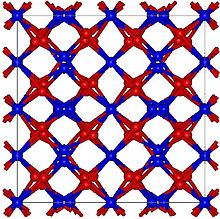


| |
| Identifiers | |
|---|---|
3D model (JSmol) |
|
| ECHA InfoCard | 100.013.826 |
| EC Number |
|
PubChem CID |
|
| UNII | |
CompTox Dashboard (EPA) |
|
| |
| |
| Properties | |
| Zn3N2 | |
| Molar mass | 224.154 g/mol |
| Appearance | blue-gray cubic crystals[1] |
| Density | 6.22 g/cm3, solid[1] |
| Melting point | decomposes 700°C[1] |
| insoluble, reacts | |
| Structure | |
| Cubic, cI80 | |
| Ia-3, No. 206[2] | |
| Hazards | |
| GHS labelling: | |

| |
| Warning | |
| H315, H319 | |
| P264, P280, P302+P352, P305+P351+P338, P321, P332+P313, P337+P313, P362 | |
| NFPA 704 (fire diamond) | |
Except where otherwise noted, data are given for materials in their standard state (at 25 °C [77 °F], 100 kPa). | |
Zinc nitride (Zn3N2) is an inorganic compoundofzinc and nitrogen, usually obtained as (blue)grey crystals. It is a semiconductor. In pure form, it has the anti-bixbyite structure.
Zinc nitride can be obtained by thermally decomposing zincamide (zinc diamine)[3] in an anaerobic environment, at temperatures in excess of 200 °C. The by-product of the reaction is ammonia.[4]
It can also be formed by heating zinc to 600 °C in a current of ammonia; the by-product is hydrogen gas.[3][5]
The decomposition of Zinc Nitride into the elements at the same temperature is a competing reaction.[6] At 700 °C Zinc Nitride decomposes.[1] It has also been made by producing an electric discharge between zinc electrodes in a nitrogen atmosphere.[6][7] Thin films have been produced by chemical vapour deposition of Bis(bis(trimethylsilyl)amido]zinc with ammonia gas onto silica or ZnO coated alumina at 275 to 410 °C.[8]
The crystal structure is anti-isomorphous with Manganese(III) oxide. (bixbyite).[2][7] The heat of formation is c. 24 kilocalories (100 kJ) per mol.[7] It is a semiconductor with a reported bandgap of c. 3.2eV,[9] however, a thin zinc nitride film prepared by electrolysis of molten salt mixture containing Li3N with a zinc electrode showed a band-gap of 1.01 eV.[10]
Zinc nitride reacts violently with water to form ammonia and zinc oxide.[3][4]
Zinc nitride reacts with lithium (produced in an electrochemical cell) by insertion. The initial reaction is the irreversible conversion into LiZn in a matrix of beta-Li3N. These products then can be converted reversibly and electrochemically into LiZnN and metallic Zn.[11][12]
|
| |||
|---|---|---|---|
| Zinc(I) |
| ||
| Zinc(II) |
| ||
|
Salts and covalent derivatives of the nitride ion
| ||||||||||||||||||||||||||||||||||||||||||||||||||||||||||||||||||||||||||||||||||||||||||||||||||||||||||||||||||||||||||||||||||||||||||||||||||||||||||||||||||||
|---|---|---|---|---|---|---|---|---|---|---|---|---|---|---|---|---|---|---|---|---|---|---|---|---|---|---|---|---|---|---|---|---|---|---|---|---|---|---|---|---|---|---|---|---|---|---|---|---|---|---|---|---|---|---|---|---|---|---|---|---|---|---|---|---|---|---|---|---|---|---|---|---|---|---|---|---|---|---|---|---|---|---|---|---|---|---|---|---|---|---|---|---|---|---|---|---|---|---|---|---|---|---|---|---|---|---|---|---|---|---|---|---|---|---|---|---|---|---|---|---|---|---|---|---|---|---|---|---|---|---|---|---|---|---|---|---|---|---|---|---|---|---|---|---|---|---|---|---|---|---|---|---|---|---|---|---|---|---|---|---|---|---|---|---|
| ||||||||||||||||||||||||||||||||||||||||||||||||||||||||||||||||||||||||||||||||||||||||||||||||||||||||||||||||||||||||||||||||||||||||||||||||||||||||||||||||||||